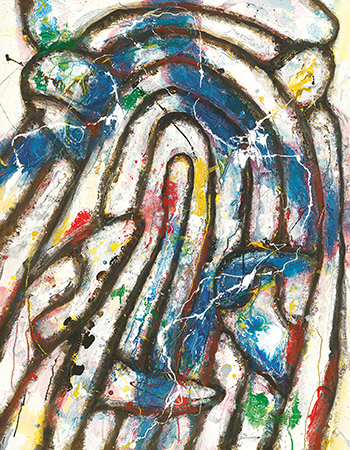PROVENANCE:
Important private collection, Asia
Christie's Hong Kong, Asian 20th Century & Contemporary Art (Evening Sale), May 30, 2015, lot 86
Acquired by the present owner from the above
EXHIBITED:
Tsuyoshi Maekawa Solo Exhibition , Whitestone Gallery, Tokyo, July 27 - September 1, 2013
Catalogue Note:
Born in Osaka, Japan in 1936, Tsuyoshi Maekawa decided to dedicate his life to art after viewing the works of Joan Miró and Paul Klee in his youth. This experience instilled in him a deep desire for creativity and freedom. Following the advent of a new post-war era, Maekawa took part in a Gutai group exhibition for the first time in 1959 (The 8th Gutai Art Exhibition). In subsequent years, he exhibited again with the group before he officially became a member in 1972. Having taken part in the art group's second phase of activities from the years of 1962 to 1972, Maekawa became one of the group's major figures along with Takesada Matsutani and Shuji Mukai. Even after the Gutai group dissolved, he persisted in his practice and expanded it overseas, spreading knowledge of his work around the world.
If one mentions Maekawa, the common thought that comes to mind is, basically, 'burlap'. This medium which for so long marked the artist's practice has today become a symbol for it. Through contortion, cutting, tearing, and destruction, he found a place for burlap on the canvas, all stitched together and shaped sculpturally, with the final touch of colour to bring the whole work tightly together. He elevated the twodimensionality of the canvas to a three-dimensional realm without such limits, in which a space is reserved for the creator's persistent emphasis of oneself as an artist. And it complied with Gutai group founder Jiro Yoshihara's supreme principle: to create unprecedented things.
For Maekawa, the answer to the question of 'what is creation' involves devoting one's life to the exploration of a medium's material qualities, yet without doing so to simply show one's tenacity. He has used hemp, cotton, and other textiles, to emphasise the tension in his work. He spares no effort to create a concentration of lines that corresponds with the surface layer. And he transforms the original state of the materials through a creative process of destruction and reproduction, in which he bares his heart. The end result, then, is what Maekawa considers to be the grounds and principle of artistic freedom.
The period between the 1950s and 1972 served as Maekawa's age of exploration, during which he took part in the Gutai art movement. In the early days of this first phase, his tones were natural, mainly focusing on the juxtaposition between the textiles and colours. His second phase, from the 1970s to 1980s, saw his solid burlap materials replaced by soft and thin cotton fibres. There was a greater precision in his sewing techniques, and this extended to a greater range of geometric shapes in his work. Finally, there are the recent years during which his artistic output has been sparse and his practice flows more comfortably. The commonly seen ripple patterns with their harmonious undulations still appear in his works. The use of symmetrical lines recalls to mind the traditional Japanese paintings of the Rinpa artists — those gorgeously ascending lines like smoke curling between dark gold tones.
In Maekawa's work, lines play a major role in consolidating the compositional structure. Following the hessian texture of the burlap, sometimes they lie low, and sometimes they lie flat out. In the early 1960s, the artist explained how he was inspired by the ancient pottery totem discovered in Uenohara, Japan. If looking at the work as if it were the ground seen from the perspective of a soaring eagle, there are mountains and rivers, fields, and plateaus that come close to what would be in nature. On the other hand, if read up close like the lines on the palm of a hand, it could be likened to a topography between five pointed mountains. A single viewer can only count on the openness of one's mind, if the fine details of the world are to be perceived.
Another important element in Maekawa's practice is a great amount of colour. Through consciously painting by hand or letting it splash and trickle with an automatic technique, all bands of colour, from large patches to tiny dots, are seen in his work. Paint is poured between the canvas and the hemp so that it fully covers the gap and they overlap each other, spreading about and seeping into and saturating all the areas that are sunken in or stuck out. It shows the experimental nature of how he combines lines and colours, as a sort of fateful collision that occurs under passive human control.
This lot, Work, was completed in 2013 and exhibited in Tsuyoshi Maekawa's solo exhibition at the Whitestone Gallery in Tokyo. It is a very rare work that has been in a private collection in Asia. The white base gives the viewer a fresh sense of perception, complemented by the liveliness of the snaking black lines, erasing the traces of this work's creation process. Between the creased layers of fabric are the reds, yellows, blues, greens of a multi-coloured, gem-like, and naturally irregular pattern from an inspired interplay that is beautiful beyond compare. The overall picture resembles the proliferating life of an atmospheric pulse — a truly magnificent example of the artist's work at its most mature.
